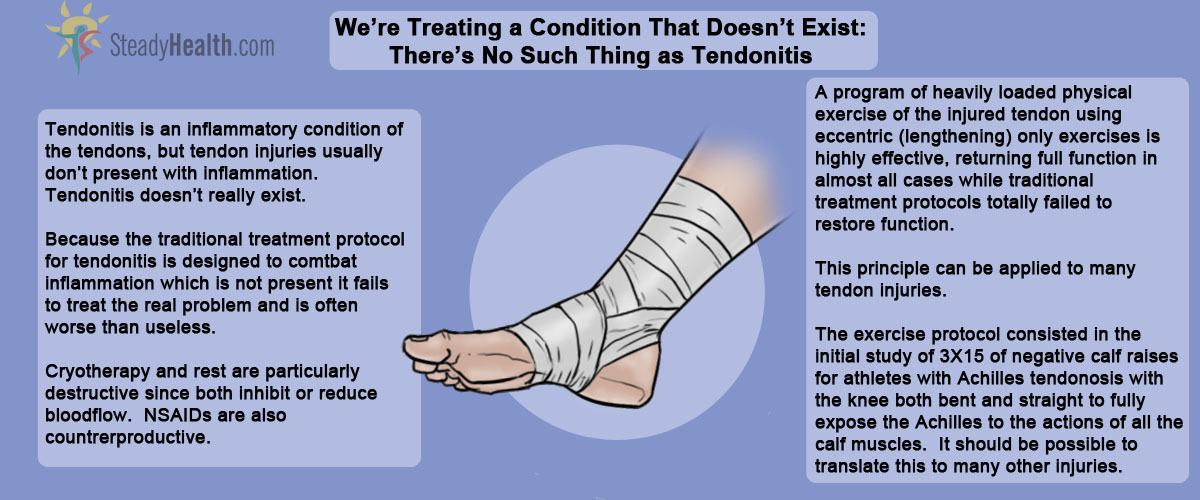Table of Contents
Tendon injuries are among the most common reasons for people showing up in the doctor's waiting room, especially amateur sportspeople. The typical attitude you're likely to encounter from your medical professional about this is:
'Sometimes the tendons become inflamed for a variety of reasons, and the action of pulling the muscle becomes irritating. If the normal smooth gliding motion of your tendon is impaired, the tendon will become inflamed and movement will become painful. This is called tendinitis, and literally means inflammation of the tendon.
The most common cause of tendinitis is overuse.'
(Source: Orthopedics.about.com)
That's probably why your medical professional will seek to treat the problem with NSAIDs (Non-Steroidal Anti-Inflammatories) like Ibuprofen, Diclofenac or paracetamol, and recommend the RICE protocol. That's Rest, Ice, Compression and Elevation, a protocol designed to reduce inflammation and restore normal function.
But what if there's no real inflammation involved?
When you go to see your doctor with an overuse injury, you're usually experiencing pain and loss of function. You're often not aware of any inflammation.
And according to the Oxford Journal of Rheumatology, that's because the nature of tendon injuries is usually 'degenerative (rather than inflammatory),' and protocols to treat inflammation are therefore 'inappropriate,' because... there isn't any. In the words of Dr. Ian McIntyre, 'The implementation of methods such as biopsies, intratendinous micro dialysis and gene technology analyses of biopsies, have shown that there are no signs of prostaglandin-mediated inflammation in chronic painful tendons. Therefore, describing this injury as inflammatory by using such terms as tendonitis cannot be justified.'
Tendons don't swell.
Reading that might sound like I'm just playing with words. Tendonitis, tendonosis, tendonopathy - call it what you will, it's the same injury, right?
Wrong.
Treating the wrong injury can be catastrophic
What if you went to hospital with a ruptured stomach and they treated you for an oral drug overdose by pumping your stomach? Kind of a problem, right?
Or what if you went to a doctor with an injury and they gave you a treatment protocol that makes the injury worse and is implicated in causing injuries like it to become chronic?
Then you'd be in good company.
Rest is the worst thing for a tendon injury. You should look for exercise that doesn't aggravate the injury, right off the bat. If your tricep's blown out, do squats. If your Achilles tendon's the culprit, do pull-ups. Find something. The sooner you start the better off you'll be down the line, as exercise both improves mood and, crucially, improves blood flow. And we want improved blood flow to the tendon area!
Ice decreases blood flow. It's a great treatment for inflammation. For a damaged tendon, we want more blood flow, not less! Remember: there's almost always no significant inflammation present, even in an acute tendon injury!
Compression does make some sense, because it can help support the joint and reduce pain. Elevation, once again, is aimed at reducing an inflammation that simply isn't there.
See Also: Knee Tendonitis: Treatment and Symptoms
That's a bold thing to say: 'totally ineffective.'
- Cluett, Jonathan, 'Tendinitis, General Information About Tendinitis,' Orthopedica.about.com, November 2010
- Håkan Alfredson, Tom Pietilä, Per Jonsson and Ronny Lorentzon, 'Heavy Load Eccentric Calf Muscle Training for the Treatment of Chronic Achilles Tendinosis,' American Journal of Sports Medicine, 1998 26: 30
- McIntyre, Ian, 'Heavy Eccentric Loading For a Recalcitrant Case of Lateral Epicondylosis in a Hockey Player: A Case Report,' Graduate Education and Research, Canadian Memorial Chiropractic College
- Rees, J. D., et al, 'Current Concepts in the Treatment of Tendon Disorders,' Oxford Journal of Rheumatology, 45: 5, pp 508-521
- Mindmap by steadyhealth.com
- Photo courtesy of Stan Dalone & Miran Rijavec by Flickr : www.flickr.com/photos/miran/209038034


